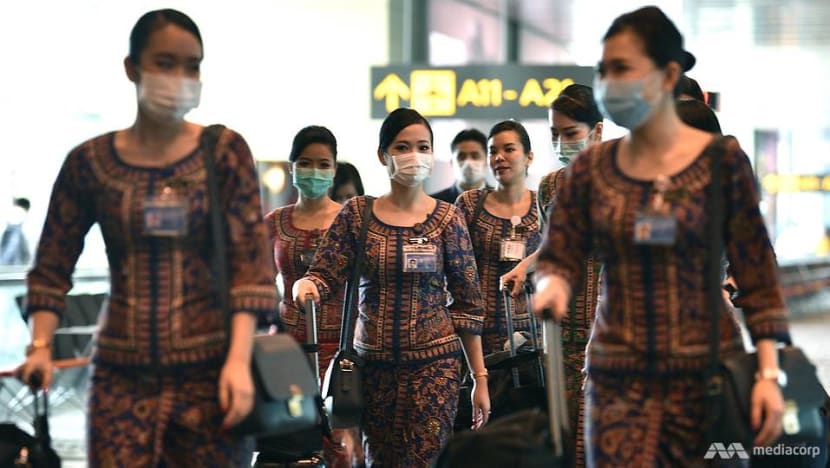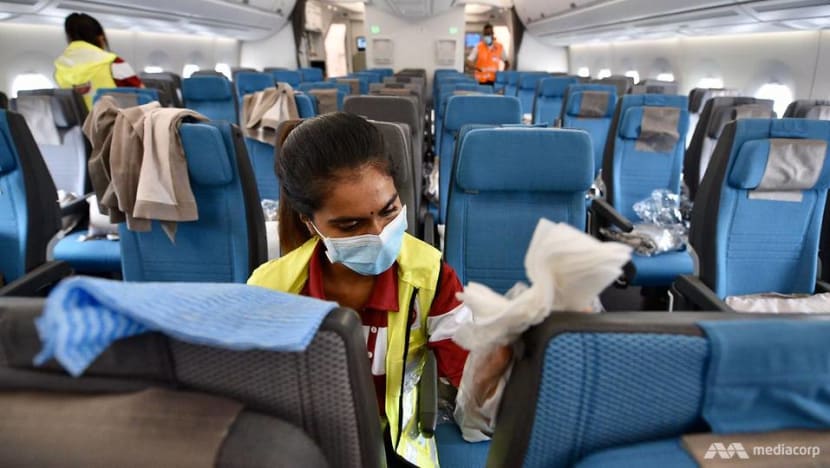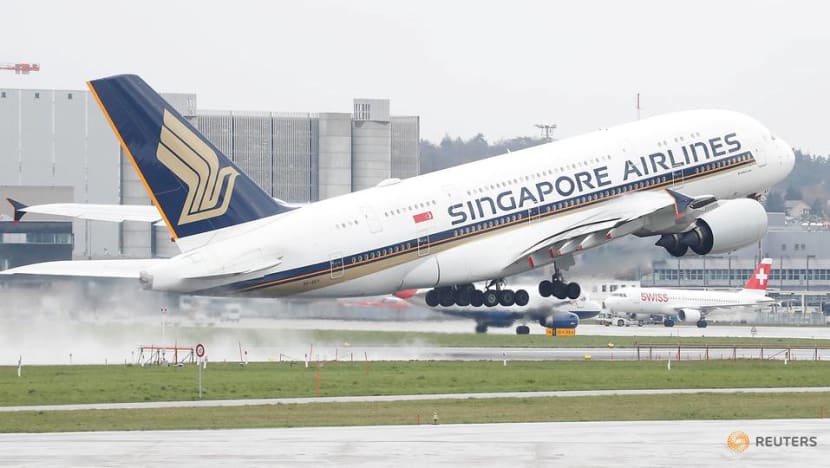commentary Commentary
Commentary: Hit hard by COVID-19, Singapore Airlines may need to pursue deeper capacity cuts
The Singapore Airlines Group is likely to incur rare losses in the March and June quarters, says Brendan Sobie.

Singapore Airlines flight attendants wearing masks at Changi Airport Terminal 3's arrivals hall. (Photo: Jeremy Long)
SINGAPORE: The 2020 outlook for Singapore Airlines (SIA) has turned from relatively bright to dismal due to COVID-19.
Singapore’s aviation and tourism industries have been significantly impacted as the virus has led to a virtual halt in travel to and from China as well as dramatic reductions in traffic to and from several other major Asian markets.
China is the largest source market for Singapore’s tourism industry and one of SIA’s largest markets. China routes accounted for around 11 per cent of SIA Group’s passenger traffic prior to the emergence of the COVID-19, which has led to all but a few of the group’s China routes being suspended and the rest being cut by over 50 per cent.
The SIA Group, which includes regional subsidiary SilkAir and budget airline Scoot, carried around 38 million passengers in 2019.
DEPENDENCE ON VISITORS FROM CHINA
Singapore Changi Airport’s total passenger traffic was 68.3 million in 2019, representing a 4 per cent increase over 2018. The inbound market (visitors travelling to Singapore for work or leisure) is Changi Airport’s largest segment, surpassing outbound (Singapore residents travelling abroad for work or leisure) and transit (passengers connecting between flights at Changi) passengers.
There were 14.9 million visitor arrivals at Changi in 2019, equating to nearly 30 million total passengers or 44 per cent of Changi’s total passenger traffic.
Chinese visitors accounted for 2.6 million or 17 per cent of total visitors arriving at Changi in 2019 according to data from the Singapore Tourism Board. Total Chinese visitor numbers to Singapore amounted to 3.6 million in 2019, a 6 per cent increase over 2018, when also including visitors arriving by land and sea.
READ: Commentary: Novel coronavirus turns 2020 into a bleak year for Asian airlines
The SIA Group carries a large portion of Singapore’s Chinese visitors. SIA also has significant China-originating traffic that connects in Singapore to other destinations – regionally within Southeast Asia and to its long-haul network. The portion of traffic on SIA Group’s China routes originating in Singapore and other countries is smaller but also significant.
Given SIA’s high reliance on mainland China it is no surprise it is one of the most impacted airline groups in Asia, excluding Chinese and Hong Kong carriers, by COVID-19.
WIDER IMPACT BEYOND CHINA
The sudden virtual zeroing of out-of-China traffic alone is enough to result in losses for the SIA Group. SIA is hardly alone as most other – and possibly all – major Asian airline groups will join SIA with losses in the March and June quarters.
But it is not just about China exposure. The impact of COVID-19 is also hitting non-China routes hard for SIA as well as other Asian airline groups.
READ: Commentary: Tourism in Asia takes a beating after Wuhan coronavirus outbreak
Singapore is experiencing sharp declines in visitor numbers from all its major source markets due to advisories placed by many countries against travelling to Singapore. As I recently told media, outbound traffic in Singapore is also impacted as residents have postponed or cancelled holiday plans and companies in Singapore have stopped all but essential business travel.

Routes connecting Singapore with other Asian countries have been most impacted but there is also reduced demand on long-haul routes from Singapore to Australasia, Europe, the Middle East, Africa and North America.
CUTS NOT ENOUGH
The SIA Group responded to reduced demand on non-China and Hong Kong routes by announcing last week capacity cuts for around 30 Singapore Airlines and SilkAir routes. Flights to Hong Kong were earlier slashed along with the suspension of most routes to mainland China.
While cutting capacity on non-China routes is sensible given the sharp reduction in demand, the cuts are surprisingly small. The total number of Singapore Airlines and SilkAir flights cancelled, around 800 in total over three months from late February to late May, represent only 2 per cent of the total flights normally operated by them over a three-month period.
READ: Commentary: The great COVID-19 disruption to Asian economies has begun
READ: Commentary: Japan shows how not to deal with a COVID-19 outbreak
The reductions on North-Asia routes other than China and Hong Kong are particularly too small. Japan and South Korea have been the most impacted outside Greater China as travel to and from these two large markets has dramatically declined.
However, SIA has cut only a handful of its Japan flights for March and April. The May cuts in the Japan market are more significant but still represent less than 10 per cent of its total Japan capacity. The Korea cuts start in late February and are more but total Korea capacity is being cut by only about 10 per cent over the three-month period.
Most of the long-haul route cuts are limited to May, which is an off-peak month for travel to Europe, North America and Australia. SIA is cutting long-haul flights that would have not performed well regardless of COVID-19 although there is now even weaker demand due to the virus.
A lot of passengers who would have normally booked flights for April and May in February are waiting to see what happens with the virus before firming any travel plans.

Singapore Airlines and SilkAir will likely need to cut more of its non-China flights for March, April and May, particularly regional flights within Asia.
As it is, the current cuts it announced last week are already less than the drop in demand. So even if the demand stabilises at the current reduced level and it doesn’t get worse than this, SIA will have the problem of over-capacity. If the virus is not contained soon, extending some of the cuts to June and July is also likely.
Scoot, which has so far only announced cuts to China, will also need to pursue significant cuts on its non-China routes. Scoot’s rival, Singapore-based budget airline Jetstar Asia, last week announced a 15 per cent cut in capacity across its entire network. This includes China and Hong Kong but Jetstar Asia has a small presence in these markets while Scoot has more exposure to China than any Singapore-based airline.
READ: Commentary: Singapore Airshow in a COVID-19 outbreak – smaller but not quite
Other Asian airlines have also been very slow to cut capacity on non-China routes. Airlines throughout the region should consider immediate and significant capacity cuts on non-China routes to avoid flying half-empty planes over the next few months.
OTHER MEASURES NEEDED
SIA and other Asian airline groups also need to consider unpaid leave schemes, which is the strategy often used by airlines when there is a need to cut capacity for a few months. Assuming that the market will recover once the threat from the virus ends, this is a more prudent strategy than cutting jobs entirely.
Outside of China and Hong Kong, only Korea’s Asiana has so far announced unpaid leave for crew. The SIA Group has so far decided against offering an unpaid leave scheme in order to have enough crew in place to operate a full schedule when the virus becomes contained. This decision could backfire if the virus is not contained soon.
Most financial analysts I have spoken to are now projecting the SIA Group to post losses in the March and June quarters.
The March quarter loss will offset some of the S$520 million net profit and S$862 million operating profit the group generated in the nine months ending December but the SIA Group will comfortably remain in the black for the fiscal year ending March.
SIA will be able to weather the current storm and is fortunate to have had a great quarter ending December, reporting a group net profit of S$449 million. In fact, the profit turned by the parent airline for the three months ending Dec 31, 2019 was the highest in over a decade.
SIA’s annual profit streak will also remain intact. The group has never incurred an annual loss in its history, an incredible achievement.
READ: Commentary: Can you really fly sustainably? And do these carbon offsets work?
During SARS, the SIA Group escaped an annual loss as the impact was spread across two fiscal years and the recovery was fast after a dismal quarter ending June 2003. SIA will again have dismal June and March quarters but a rapid recovery is again likely, leading to a return to profitability starting in the September quarter.
However, at the moment SIA needs to respond accordingly. The group has so far reacted too slowly in cutting capacity, particularly on non-China routes, and has not been transparent enough about the financial impact.
How the situation and Asia’s aviation market evolve over the next several weeks is unpredictable.
Big decisions will need to made in the coming weeks that will capture headlines and move stock prices. Airlines that make the right decisions will be able to minimise losses and improve their long-term position.
Brendan Sobie is the founder of Singapore-based independent aviation consulting and analysis firm Sobie Aviation. He was previously chief analyst for CAPA - Centre for Aviation.












